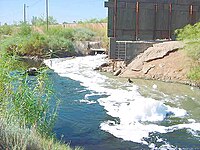
Photo from wikipedia
Microplastics are proven as heavy metals vector, but the adsorption mechanism still unclear. This study investigated the adsorption of Pb and Cu in microplastics in the Musi River and the… Click to show full abstract
Microplastics are proven as heavy metals vector, but the adsorption mechanism still unclear. This study investigated the adsorption of Pb and Cu in microplastics in the Musi River and the environment effect. This study was conducted in 10 stations along the Musi River to the estuary. The polymers of microplastics were dominated by PP and followed by PE, PES, PVC, and nylon. The average concentration of Pb (0.0347 mg L-1 for water and 0.470 mg kg-1 for microplastics) was higher than Cu (0.0138 mg L-1 for water and 0.091 mg kg-1 for microplastics). The highest concentration of both metals in water and microplastics were found in the estuary. Environment parameters have different effects on the adsorption. The present study found that the adsorption processes were following the Freundlich model. The interaction metal-microplastic was physisorption. Pb and Cu will attach through weak bonds and easy to release into the aquatic ecosystem.
Journal Title: Marine pollution bulletin
Year Published: 2020
Link to full text (if available)
Share on Social Media: Sign Up to like & get
recommendations!